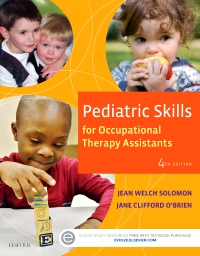
Pediatric Skills for Occupational Therapy Assistants - Elsevier eBook on VitalSource, 4th Edition
Elsevier eBook on VitalSource

Now $80.74
Learn to provide effective therapy for children and adolescents with Pediatric Skills for Occupational Therapy Assistants, 4th Edition. This market-leading text offers a comprehensive, application-focused guide to pediatric occupational therapy assisting by incorporating the AOTA Practice Framework. The text’s focused and easy-to-use approach to pediatrics covers everything from the scope of practice to in-depth coverage of normal development, pediatric health conditions, and treatment planning. This new edition has also been thoroughly updated and expanded to include new content and chapters on community systems, physical agent modalities, the Model of Human Occupation assessments, childhood obesity, documentation, neurodevelopmental treatment, and concepts of elongation.
Newer Edition Available
Pediatric Skills for Occupational Therapy Assistants Elsevier eBook on VitalSource
-
- Utilizes a family-centered perspective, using the terminology of the AOTA Practice Framework, which focuses on tailoring the OT approach to meet the needs of children within the context of their own environments.
- Includes evidence-based content such as clinical trials and outcome studies that demonstrate the basis for OTA best practices.
- Presents case examples that show how key concepts apply to real-life situations.
- UNIQUE! Features expert advice and tips from the authors and contributors in highlighted Clinical Pearls boxes.
- Addresses cultural diversity and sensitivity to introduce you to the wide groups of people that OTAs treat.
- Incorporates prevention as a role OTA’s have in addition to intervention and treatment.
- Contains suggested activities in each chapter that help bridge the gap between the classroom and the clinic.
- Prepares you for the information you’re expected to learn from the chapter with key terms, chapter outlines, and chapter objectives at the beginning of each chapter.
- Helps you assess and evaluate what you’ve learned with review questions and summaries at the end of each chapter.
- UNIQUE! Evolve website offers a variety of video clips and learning activities to help reinforce the material you learn in the text.
-
- NEW! Content on emerging areas of practice (such as community systems) broadens readers’ awareness of where interventions for children can take place.
- NEW! Content on physical agent modalities (PAMS) outlines the theory and application of PAMS as used by OTAs with pediatric clients.
- NEW! Pediatric MOHO assessments that are now available in the chapter on Model of Human Occupation (MOHO) assessments describe how these assessments can help with intervention.
- NEW! Content on childhood obesity, documentation, neurodevelopmental treatment, and concepts of elongation have been added to keep readers abreast of the latest trends and problems.
-
- Scope of Practice
- Family Systems
- Medical System
- Educational System
- Community Practice
- Principles of Normal Development
- Development of Performance Skills
- Development of Occupations
- Adolescent Development: Becoming an Adult
- The Occupational Therapy Process
- Anatomy and Physiology for the Pediatric Practitioner
- Neuroanatomy for the Pediatric Practitioner
- Pediatric Health Conditions
- Childhood and Adolescent Psychosocial and Mental Health Disorders
- Childhood and Adolescent Obesity
- Intellectual Disabilities
- Cerebral Palsy
- Positioning and Handling: An Neurodevelopmental Approach
- Activities of Daily Living (ADLs) and Sleep/Rest
- Instrumental Activities of Daily Living
- Play and Playfulness
- Functional Task at School: Handwriting
- Therapeutic Media: Activity with Purpose
- Motor Control and Motor Learning
- Sensory Processing/Integration and Occupation
- Applying the Model of Human Occupation to Pediatric Practice
- Assistive Technology
- Orthoses, Orthosis Fabrication, and Elastic Therapeutic Taping for the Pediatric Population
- Animal-Assisted Therapy
- Glossary
- Index


 as described in our
as described in our 